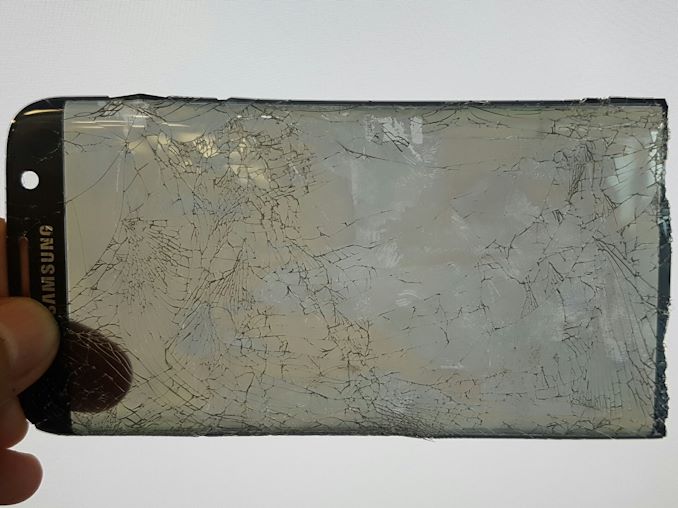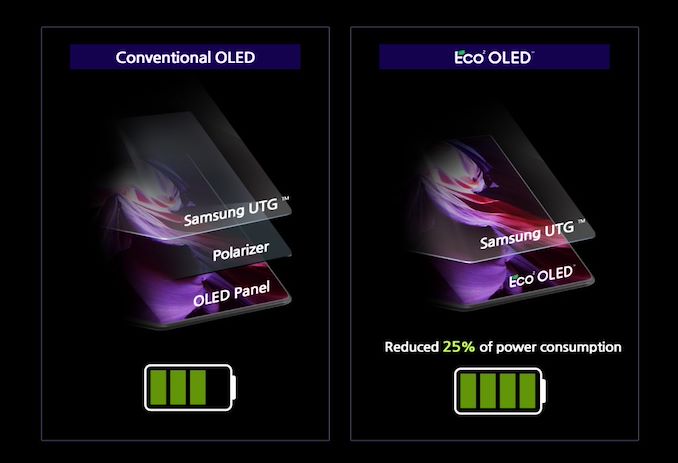Samsung Display Announces Polarizer-less OLED With 25% Less Power
by Andrei Frumusanu on August 16, 2021 12:01 PM EST- Posted in
- Mobile
- Smartphones
- OLED
- Samsung Display

Today Samsung Display Company (SDC) is announcing the introduction and mass production of a new generation of OLED panel called “Eco²OLED”. While the news here is rather short, it’s actually a massive technically undertaking and shift from past generation OLED panel technologies, as the new panel type is making due without the classical polarizer layer in-between the actual panel and cover glass.
In a traditional OLED panel, the actual panel itself is of a copper colour, which of course doesn’t work very well for displaying black. To create a reflective black, displays use polariser layers which block light from entering and reflecting off the display, only allowing light generated by the display itself to go through the glass.

Cover Glass and Polarizer on Galaxy S7
The problem with such layers is that they are of a reduced transmittance, and the polarizer itself is eating some of the light emitted by the panel. The above picture for example is the cover glass and polarizer of an old Galaxy S7, which appears notably darker than the lit background.
Samsung is explaining that they’ve managed to get rid of this polarizing layer, and are able to have non-reflective OLED panels which display as black. This is a major change in the display stack, and Samsung is quoting that they’re able to improve transmittance by a massive 33%, meaning 33% brighter screens, or at the same brightness, reduce power consumption by 25%.
These figures are massive, and should represent one of the largest jumps in power efficiency in OLEDs since their inception.
Samsung Display states that the Eco²OLED is already being used in Samsung Mobile’s Galaxy Z Fold3, meaning this should be the first phone to be able to take advantage of the technology. Along with this year’s widespread adoption of LTPO panels which massively improved power efficiency, this could signal a new large jump in smartphone power efficiency and help improve battery life of devices adopting the technology.











51 Comments
View All Comments
Wereweeb - Tuesday, August 17, 2021 - link
It's 2021, not 2014. The more efficient OLEDs get, the less relevant burn-in is going to be relevant (And it wasn't even that relevant back then)Wrs - Wednesday, August 18, 2021 - link
My S10 and buddy's C9 OLED - both 2019 models - look like a fusion of vibrant OLED and subpar LCD. S10 has been used at half-brightness on average 4-5h/day, the C9 closer to max brightness and not as a PC monitor (it doesn't get very bright). Burn-in started for me about a year in, basically any gaming HUDs and web site fixed elements that I've spent considerable time with have left a ghostly trail. Fortunately I knew to expect this going in.The solutions could include running panels extra dim, not using them that much, alternating with a secondary display, rotating the image, (on TVs) performing panel refreshes... annoyances unbecoming of a premium-priced panel. So rather than aching my head I'm just considering OLED as expensive throwaway tech until proven otherwise. It remains productive if ugly, of course, though so does a cheap LCD. And you just can't know with a 2021 OLED whether it'll look bad until 2022/23, unless someone torture tests it a few months. I know of no OLED that has survived such a test unscathed... see all the past photos on Rtings.
eek2121 - Wednesday, September 1, 2021 - link
I've never had an issue on burn-in with mobile devices. My screen is on for a handful of hours a day. My phone says 4 hours for today. Usually it is 3-4 hours, but on a lazy weekend it might be 6.No burn in. I upgrade almost every year, my usage patterns have been similar. I've owned smart phones since before the iPhone and 80% of them weren't LCD.
Oxford Guy - Tuesday, September 7, 2021 - link
'The more efficient OLEDs get, the less relevant burn-in is going to be'Citation needed.
The passage of time doesn't necessarily fix fundamental drawbacks in specific areas of tech.
melgross - Wednesday, September 1, 2021 - link
I have the 12.9” iPad Pro. This mini LED display does NOT have artifacts. In a dark room, if you have a large white area inside of a large black area, you can see a very minor amount of halo. But otherwise, nothing.And I’ve seen a similar halo with OLED. But the mini LED screen has much better off axis brightness and color that OLED.
venyaz - Tuesday, August 17, 2021 - link
Not only Samsung. LG provides half of iPhone OLED displays, also some of them made by BOERazor54672 - Monday, August 16, 2021 - link
I think modern smartphone components are very powerful for an average user. A focus on practical features, efficiency, usability, sustainability should be emphasised going forward. Better battery life is much appreciated.quorm - Monday, August 16, 2021 - link
Too bad they will just use this as an opportunity to make a slightly thinner phone with a smaller battery.caribbeanblue - Monday, August 16, 2021 - link
I don't think the flagships can get any thinner than how thin they currently are, because of all of their camera components. Budget phones could lean more towards getting thinner, and we have seen the Xiaomi Mi 11 Lite suggesting that trend, but only time will tell. I think we still have a ways to go till we eliminate all the bottlenecks in our phones, though, so I'm still for them increasing the performance every year.drajitshnew - Wednesday, August 18, 2021 - link
I have had to go to realme (oppo) service centers 3 times, because updates kept bricking my phone -- and the no1 complaint of customers is -- my battery runs out quickly. After using most people I know would accept 1-2 mm thicker and 20 to 30 gm heavier phones if they can get a 5000mAH or better battery